How to Charge: Samsung G988B-DS Galaxy S20 Ultra 5G User Manual
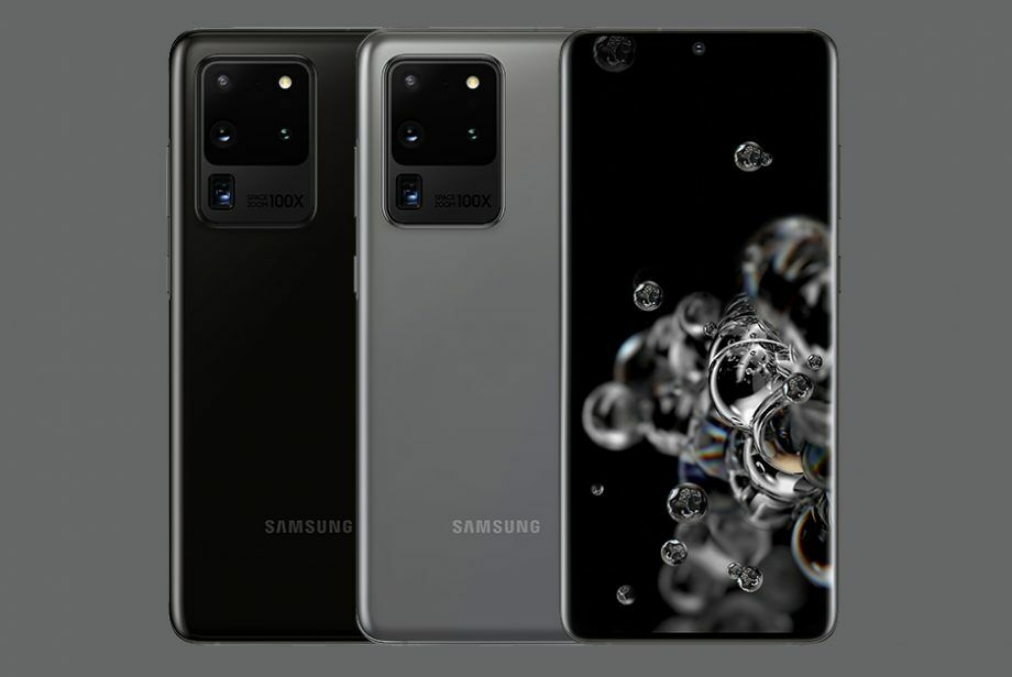
Content
Introduction
This premium smartphone, the Samsung G988B-DS Galaxy S20 Ultra 5G, offers an unmatched mobile experience by fusing state-of-the-art technology with an elegant appearance. With its breathtaking 6.9-inch Dynamic AMOLED display, the Galaxy S20 Ultra is an excellent choice for productivity, gaming, and streaming since it provides clear, vivid images. With 5G connectivity, you can expect blazing-fast download and streaming rates from this gadget, which keeps you connected everywhere you go. With its sophisticated quad-camera setup that includes a 108MP primary sensor and a 100x Space Zoom, the S20 Ultra lets you record every detail with quality befitting a professional. For those who expect the latest smartphone technology available, the Galaxy S20 Ultra is the best option thanks to its powerful Exynos 990 processor, 12GB of RAM, and 5000mAh battery. It is designed for exceptional performance.
Detailed Specifications
| Brand | Samsung |
| Operating system | Android 10.0 |
| CPU model | Snapdragon |
| Memory storage capacity | 12 GB |
| Screen Size | 6.9 Inches |
| Model name | Galaxy S20 Ultra 5G |
| Cellular technology | 5G |
| Connectivity technology | Bluetooth, Wi-Fi, USB, NFC |
| Colour | gray |
| Wireless network technology | GSM |
Device layout and functions
Package contents
Refer to the quick start guide for package contents.
- The items supplied with the device and any available accessories may vary depending on the region or service provider.
- The supplied items are designed only for this device and may not be compatible with other devices.
- Appearances and specifications are subject to change without prior notice.
- You can purchase additional accessories from your local Samsung retailer. Make sure they are compatible with the device before purchase.
- Use only Samsung-approved accessories. Using unapproved accessories may cause the performance problems and malfunctions that are not covered by the warranty.
- The availability of all accessories is subject to change depending entirely on manufacturing companies. For more information about available accessories, refer to the Samsung website.
- The supplied earphones (USB Type-C) which support digital output are designed only for this device. They may not be compatible with other devices that use different audio output methods.
Device layout
Galaxy S20 Ultra 5G, S20 Ultra:
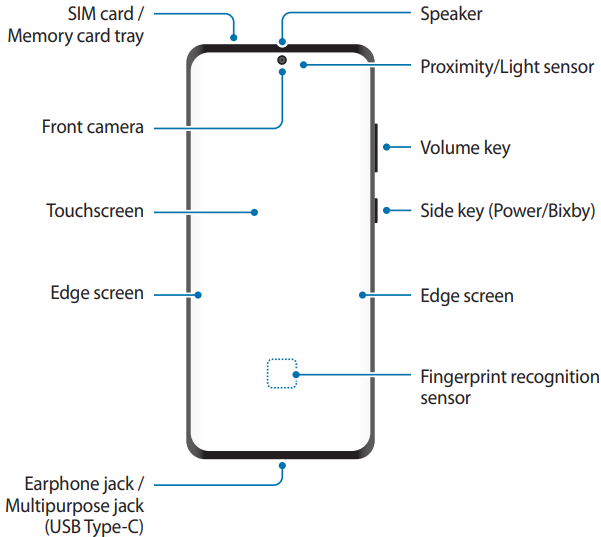
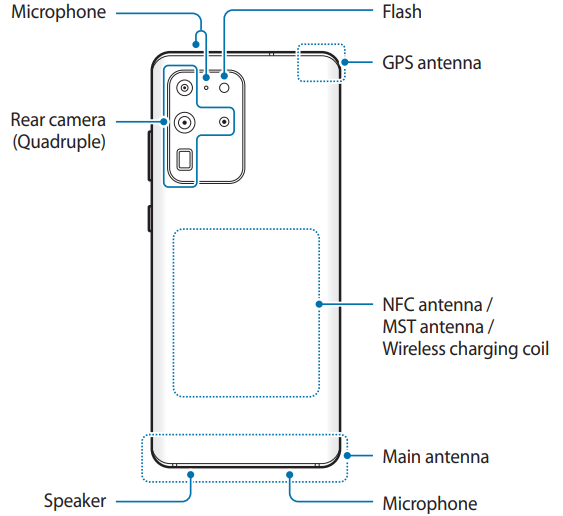
INFO
- When using the speakers, such as when playing media files or using a speakerphone, do not place the device close to your ears.
- Be careful not to expose the camera lens to a strong light source, such as direct sunlight. If the camera lens is exposed to a strong light source, such as direct sunlight, the camera image sensor may be damaged. A damaged image sensor is irreparable and will cause dots or spots in pictures.
- If you use the device with its glass or acrylic body broken, there may be a risk of injury. Use the device only after it has been repaired at a Samsung Service Centre.
- If dust or foreign materials enter the microphone, speaker, or receiver, the device’s sound may become quiet or certain features may not work. If you attempt to remove the dust or foreign materials with a sharp object, the device may be damaged and its appearance may be affected.
TIPS
- Connectivity problems and battery drain may occur in the following situations:
- If you attach metallic stickers on the antenna area of the device
- If you attach a device cover made with metallic material to the device
- If you cover the device’s antenna area with your hands or other objects while using certain features, such as calls or the mobile data connection
- Using a Samsung-approved screen protector is recommended. Unapproved screen protectors may cause the sensors to malfunction.
- Do not cover the proximity/light sensor area with screen accessories, such as a screen protector, stickers, or a cover. Doing so may cause the sensor to malfunction.
- The light may flicker at the top of the device during calls due to proximity sensor operation.
- The colours on the Edge screen may look different depending on your viewing position.
Hard keys
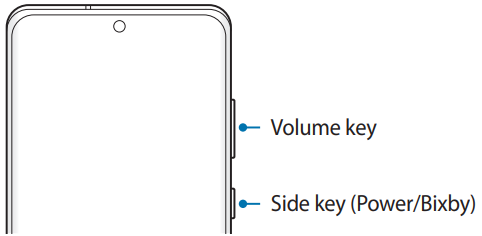
Key | Function |
Volume key |
|
Side key |
|
Side key + VolumeDown key |
|
Setting the Side key
- Select an app or feature to launch by pressing the Side key twice or pressing and holding the Side key.
- Launch the Settings app, tap Advanced features → Side key, and then select an option you want.
Soft buttons
When you turn on the screen, the soft buttons will appear at the bottom of the screen. The soft buttons are set to the Recents button, Home button, and Back button by default. Refer to Navigation bar (soft buttons) for more information.

Battery
Charging the battery
Charge the battery before using it for the first time or when it has been unused for extended periods.
CAUTION
Use only Samsung-approved battery, charger, and cable specifically designed for your device. Incompatible battery, charger, and cable can cause serious injuries or damage to your device.
WARNING
- Connecting the charger improperly may cause serious damage to the device. Any damage caused by misuse is not covered by the warranty.
- Use only USB Type-C cable supplied with the device. The device may be damaged if you use Micro USB cable.
INFO
To save energy, unplug the charger when not in use. The charger does not have a power switch, so you must unplug the charger from the electric socket when not in use to avoid wasting power. The charger should remain close to the electric socket and easily accessible while charging.
- Connect the USB cable to the USB power adaptor.
Plug the USB cable into the device’s multipurpose jack.
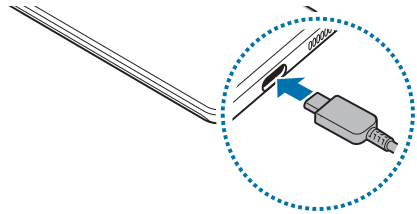
- Plug the USB power adaptor into an electric socket.
- After fully charging, disconnect the charger from the device. Then, unplug the charger from the electric socket.
Reducing the battery consumption
Your device provides various options that help you conserve battery power.
- Optimize the device using the device care feature.
- W hen you are not using the device, turn off the screen by pressing the Side key.
- Activate power saving mode.
- Close unnecessary apps.
- Deactivate the Bluetooth feature when not in use.
- Deactivate the auto-syncing of apps that need to be synced.
- Decrease the backlight time.
- Decrease the screen brightness.
Battery charging tips and precautions
- When the battery power is low, the battery icon appears empty.
- If the battery is completely discharged, the device cannot be turned on immediately when the charger is connected. Allow a depleted battery to charge for a few minutes before turning on the device.
- If you use multiple apps at once, network apps, or apps that need a connection to another device, the battery will drain quickly. To avoid losing power during a data transfer, always use these apps after fully charging the battery.
- Using a power source other than the charger, such as a computer, may result in a slower charging speed due to a lower electric current.
- The device can be used while it is charging, but it may take longer to fully charge the battery.
- If the device receives an unstable power supply while charging, the touchscreen may not function. If this happens, unplug the charger from the device
- While charging, the device and the charger may heat up. This is normal and should not affect the device’s lifespan or performance. If the battery gets hotter than usual, the charger may stop charging. If this occurs during wireless charging, disconnect the device from the charger to let it cool down, then charge the device again later.
- If you charge the device while the multipurpose jack is wet, the device may be damaged. Thoroughly dry the multipurpose jack before charging the device.
- If the device is not charging properly, take the device and the charger to a Samsung Service Centre.
Super fast charging
The device has a built-in super fast charging feature so you can charge the battery more quickly. To use the super fast charging feature, you must use the battery charger supplied with the device and the super fast charging feature must be activated.
If the super fast charging feature is not activated, launch the Settings app, tap Device care → Battery → Charging, and then tap the Super fast charging switch to activate it. When you connect a fast battery charger, you can charge the battery with the fast charging feature. When the pop-up window appears on the device, tap Turn on. Alternatively, launch the Settings app, tap Device care → Battery → Charging, and then tap the Fast charging switch to activate it.
INFO
- While charging, you cannot activate or deactivate this feature.
- To use the super fast charging feature, use a USB PD (Power Delivery) charger that supports Super fast charging.
- To use the fast charging feature, use a battery charger that supports Adaptive fast charging.
- You cannot use the fast charging feature or the super fast charging feature when you charge the battery using a standard battery charger.
- If the device heats up or the ambient air temperature rises, the charging speed may decrease automatically. This is a normal operating condition to prevent damage to the device.
- You can charge the battery more quickly while the device or its screen is turned off.
Wireless charging
The device has a built-in wireless charging coil. You can charge the battery using a wireless charger (sold separately).
Fast wireless charging
You can charge your device faster using the fast wireless charging feature. A fan inside the charger may produce noise during fast wireless charging.
Launch the Settings app, tap Device care → Battery → Charging → Fast wireless charging. You can turn off or on the fast wireless charging feature by tapping the On or Off switch. If you use the Turn off as scheduled option, you can set the fast wireless charging feature to turn off automatically at the preset time. When the fast wireless charging feature turns off, the charger’s fan noise and the indicator light will be reduced.
INFO
- To use this feature, you must use a charger and components that support the fast wireless charging feature.
- While charging, you cannot activate or deactivate this feature.
Charging the battery
Place the centre of the device’s back on the centre of the wireless charger.
The estimated charging time will appear on the notification panel. The actual charging time may vary depending on the charging conditions.
After fully charging, disconnect the device from the wireless charger.
Precautions for wireless charging- Do not place the device on the wireless charger with a credit card or radio-frequency identification (RFID) card (such as a transportation card or a key card) placed between the back of the device and the device cover.
- Do not place the device on the wireless charger when conductive materials, such as metal objects and magnets, are placed between the device and the wireless charger.
The device may not charge properly or may overheat, or the device and the cards may be damaged.
INF0
- If you use the wireless charger in areas with weak network signals, you may lose network reception.
- Use Samsung-approved wireless chargers. If you use other wireless chargers, the battery may not charge properly.
Wireless PowerShare
You can charge another device with your device’s battery. You can still charge another device even while charging your device. Depending on the type of accessories or cover being used, the Wireless PowerShare feature may not work properly. It is recommended to remove any accessories and cover being used before using this feature.
NOTE: Do not use earphones while sharing power. Doing so may affect nearby devices.
- Open the notification panel, swipe downwards, and then tap
 (Wireless PowerShare) to activate it.
(Wireless PowerShare) to activate it. - Place the other device on the center of your device, with their backs facing.
INFO- When charging starts, a notification sound or vibration will occur.
- The location of the wireless charging coil may vary by device model. Adjust the devices to connect with each other properly.
Some features are not available while sharing power.

- When you are finished charging, disconnect the other device from your device.
INFO- Only devices that support the wireless charging feature can be charged using this feature. Some devices may not be charged. To see devices that support the Wireless PowerShare feature, visit www.samsung.com.
- To charge properly, do not move or use either device while charging.
- The power charged to the other device may be less than the amount shared to it by your device.
- If you charge the other device while charging your device, the charging speed may decrease or the device may not charge properly depending on the charger type.
- The charging speed or efficiency may vary depending on the device’s condition or the surrounding environment.
Setting the limit for power sharing
- You can set the device to stop power sharing when the remaining battery power drops below a certain level.
- Launch the Settings app, tap Device care → Battery → Wireless PowerShare → Battery limit, and then set the limit.
Description
This high-end smartphone, the Samsung G988B-DS Galaxy S20 Ultra 5G, has an amazing display, strong performance, and sophisticated photography features. The device's Dynamic AMOLED 2X display and 120Hz refresh rate are designed to deliver an immersive visual experience. Up to 16GB of RAM in conjunction with the Exynos 990 CPU guarantees swift and fluid performance. With a 108MP primary sensor at the center of the quad-camera arrangement, users may take beautiful pictures and videos. Extended battery life is guaranteed by the 5000mAh battery, while dependable and swift internet speeds are offered by 5G connectivity.
Transferring data from your previous device
(Smart Switch)
You can use Smart Switch to transfer data from your previous device to your new device. Launch the Settings app and tap Accounts and backup → Smart Switch.
HINT
- This feature may not be supported on some devices or computers.
- Limitations apply. Visit www.samsung.com/smartswitch for details. Samsung takes copyright seriously. Only transfer content that you own or have the right to transfer.
Transferring data using a USB cable
You can connect your previous device to your device with the USB cable to easily and quickly transfer data.
Connect your device and the previous device using your device’s USB cable.
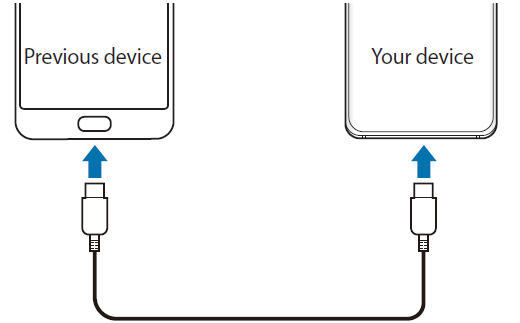
- When the app selection pop-up window appears, tap Smart Switch → Receive data.
- In the previous device, tap Allow.
If you do not have the app, download it from Galaxy Store or Play Store.
Your device will recognize the previous device and a list of data you can transfer will appear. - Select an item to bring and tap Transfer.
- Follow the on-screen instructions to transfer data from the previous device.
After the data is done transferring, you can view a list of the transferred data on your device.- INFO
Do not disconnect the USB cable from the device when you are transferring files. Doing so may cause data loss or device damage. - HINT
A USB connector may be needed depending on the previous device. Transferring data increases the battery power consumption of your device. Ensure that your device is sufficiently charged before transferring data. If the battery power is low, data transfer may be interrupted.
- INFO
Transferring data wirelessly
Transfer data from your previous device to your device wirelessly via Wi-Fi Direct.
- On the previous device, launch Smart Switch.
If you do not have the app, download it from Galaxy Store or Play Store. - On your device, launch the Settings app and tap Accounts and backup → Smart Switch.
- Place the devices near each other.
- On the previous device, tap Send data → Wireless.
- On the previous device, tap Allow.
- On your device, select an item to bring and tap Transfer.
- Follow the on-screen instructions to transfer data from your previous device.
After the data is done transferring, you can view a list of the transferred data on your device.
Backing up and restoring data using external storage
Transfer data using external storage, such as a microSD card.
- Back up data from your previous device to external storage.
- Insert or connect the external storage device to your device.
- On your device, launch the Settings app and tap Accounts and backup → Smart Switch
 Restore.
Restore. - Follow the on-screen instructions to transfer data from external storage.
Transferring backup data from a computer
Transfer data between your device and a computer. You must download the Smart Switch computer version app from www.samsung.com/smartswitch. Back up data from your previous device to a computer and import the data to your device.
- On the computer, visit www.samsung.com/smartswitch to download Smart Switch.
- On the computer, launch Smart Switch.
TIP: If your previous device is not a Samsung device, back up data to a computer using a program provided by the device’s manufacturer. Then, skip to the fifth step. - Connect your previous device to the computer using the device’s USB cable.
- On the computer, follow the on-screen instructions to back up data from the device. Then, disconnect your previous device from the computer.
- Connect your device to the computer using the USB cable.
- On the computer, follow the on-screen instructions to transfer data to your device.
Notification panel
When you receive new notifications, such as messages or missed calls, indicator icons appear on the status bar. To see more information about the icons, open the notification panel and view the details. To open the notification panel, drag the status bar downwards. To close the notification panel, swipe upwards on the screen.
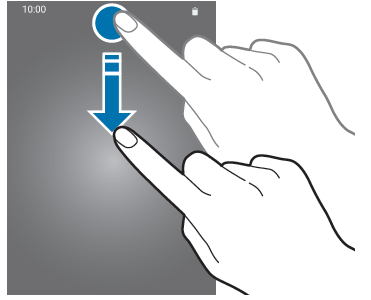
You can use the following functions on the notification panel.

Using quick setting buttons
Tap quick setting buttons to activate certain features. Swipe downwards on the notification panel to view more buttons.
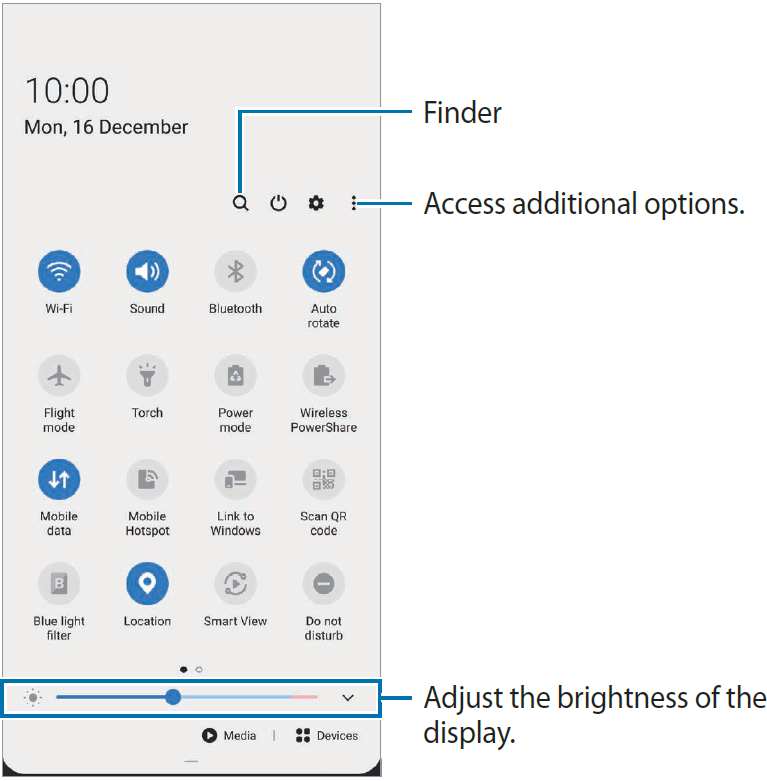
To change feature settings, tap the text under each button. To view more detailed settings, tap and hold a button.
To rearrange buttons, tap![]() → Button order, tap and hold a button, and then drag it to another location.
→ Button order, tap and hold a button, and then drag it to another location.
Controlling media playback
Take control of music or video playback easily using the Media feature. You can also continue playback on another device.
- Open the notification panel and tap Media.
- Tap the icons on the controller to control the playback.
To continue playback on another device, tap and select the device you want.
and select the device you want.
Controlling nearby devices
Launch quickly and take control of nearby connected devices and frequently used SmartThings devices and scenes on the notification panel.
- Open the notification panel and tap Devices.
Nearby connected devices and SmartThings devices and scenes will appear. - Select a nearby device or a SmartThings device to control it, or select a scene to launch it.
Screen capture and screen record
Screen capture
Capture a screenshot while using the device and write on, draw on, crop, or share the captured screen. You can capture the current screen and scrollable area.
How to capture a screenshot
Use the following methods to capture a screenshot. You can view the captured screenshots in Gallery.
- Method 1)
Key capture: Press the Side key and the Volume Down key simultaneously. - Method 2)
Swipe capture: Swipe your hand to the left or right across the screen.
TIP
- It is not possible to capture a screenshot while using some apps and features.
- If capturing a screenshot by swiping is not activated, launch the Settings app, tap Advanced features → Motions and gestures, and then tap the Palm swipe to capture switch to activate it.
After capturing a screenshot, use the following options on the toolbar at the bottom of the screen:

 : Capture the current content and the hidden content on an elongated page, such as a webpage. When you tap , the screen will automatically scroll down and more content will be captured.
: Capture the current content and the hidden content on an elongated page, such as a webpage. When you tap , the screen will automatically scroll down and more content will be captured. : Write or draw on the screenshot or crop a portion from the screenshot. You can view the cropped area in Gallery.
: Write or draw on the screenshot or crop a portion from the screenshot. You can view the cropped area in Gallery. : Add tags to the screenshot. To search for screenshots by tag, tap Search at the top of the Apps screen. You can view the tags list and easily search for the screenshot you want.
: Add tags to the screenshot. To search for screenshots by tag, tap Search at the top of the Apps screen. You can view the tags list and easily search for the screenshot you want. : Share the screenshot with others.
: Share the screenshot with others.
TIP
If the options are not visible on the captured screen, launch the Settings app, tap Advanced features → Screenshots and screen recorder, and then tap the Screenshot toolbar switch to activate it.
Screen record
Record the screen while using your device.
- Open the notification panel, swipe downwards, and then tap
.png) (Screen recorder) to activate it.
(Screen recorder) to activate it. - Select a sound setting and tap Start recording.
After a countdown, the recording will start.- To write or draw on the screen,
 tap .
tap . - To record the screen with a video overlay of yourself, tap
.png) .
.
- To write or draw on the screen,
- When you are finished recording the video, tap
 .
.
You can view the video in the Gallery.
TIP: To change the screen recorder settings, launch the Settings app and tap Advanced features → Screenshots and screen recorder → Screen recorder settings.
Samsung G988B-DS Galaxy S20 Ultra 5G Display
Options
Change the display and the Home screen settings. On the Settings screen, tap Display.
- Light / Dark: Activate or deactivate dark mode.
- Dark mode settings: Reduce eye strain by applying the dark theme when using the device at night or in a dark place. Refer to Dark mode settings for more information.
- Brightness: Adjust the brightness of the display.
- Adaptive brightness: Set the device to keep track of your brightness adjustments and apply them automatically in similar lighting conditions.
- Motion smoothness: Change the refresh rate of the screen. When a high refresh rate is set, the screen will scroll more smoothly. Refer to Motion smoothness for more information.
- Blue light filter: Activate the blue light filter and change the filter settings. Refer to Blue light filter for more information.
- Screen mode: Change the screen mode to adjust the display’s colour and contrast. Refer to Changing the screen mode or adjusting the display colour for more information.
- Font size and style: Change the font size and style. Refer to Font size and style for more information.
- Screen zoom: Change the screen zoom setting.
- Screen resolution: Change the screen resolution. Refer to Screen resolution for more information.
- Full-screen apps: Select apps to use with the full screen aspect ratio. You can also set the device to hide the front camera from the screen.
- Screen timeout: Set the length of time the device waits before turning off the display’s backlight.
- Home screen: Configure settings for the Home screen, such as the screen grid or layout.
- Easy mode: Switch to easy mode to display larger icons and apply a simpler layout to the Home screen.
- Edge screen: Change the settings for the Edge screen. Refer to Edge screen for more information.
- Navigation bar: Change the navigation bar settings. Refer to Navigation bar (soft buttons) for more information.
- Accidental touch protection: Set the device to prevent the screen from detecting touch input when it is in a dark place, such as a pocket or bag.
- Touch sensitivity: Increase the touch sensitivity of the screen for use with screen protectors.
- Show charging information: Set the device to display the remaining battery percentage and the estimated time until it is fully charged when the screen is off.
- Screensaver: Set the device to launch a screensaver when the device is charging. Refer to Screensaver for more information.
Dark mode settings
Reduce eye strain by applying the dark theme when using the device at night or in a dark place.
TIP
The dark theme may not be applied in some apps. You can quickly activate or deactivate dark mode on the notification panel. Open the notification panel, swipe downwards, and then tap (Dark mode).
- On the Settings screen, tap Display and tap Dark to activate it.
- To set the schedule to apply dark mode to the screen, tap Dark mode settings, tap the Turn on as scheduled switch to activate it, and then select an option.
- Sunset to sunrise: Set the device to turn on dark mode at night and turn it off in the morning based on your current location.
- Custom schedule: Set a specific time to turn on and off dark mode.
Motion smoothness
The refresh rate is the number of times the screen is refreshed every second. Use a high refresh rate to prevent the screen from flickering when switching between screens. The screen will scroll more smoothly. When you select a standard refresh rate, you can use the battery longer.
- On the Settings screen, tap Display → Motion smoothness.
- Select a refresh rate.
- High refresh rate (120 Hz): Use a high refresh rate for the screen to switch more smoothly.
- Standard refresh rate (60 Hz): Use a standard refresh rate in normal situations to conserve battery power.
Blue light filter
Reduce eye strain by limiting the amount of blue light emitted by the screen.
- On the Settings screen, tap Display → Blue light filter and tap the Turn on now switch to activate it.
- Drag the adjustment bar to adjust the filter’s opacity.
- To set the schedule to apply the blue light filter to the screen, tap the Turn on as scheduled switch to activate it and select an option.
- Sunset to sunrise: Set the device to apply the blue light filter at night and turn it off in the morning based on your current location.
- Custom schedule: Set a specific time to apply the blue light filter.
Changing the screen mode or adjusting the display colour
Change the screen mode or adjust the display colour to your preference.
Changing the screen mode
On the Settings screen, tap Display → Screen mode and select a mode you want.
- Vivid: This optimises the colour range, saturation, and sharpness of your display. You can also adjust the display colour balance by colour value.
- Natural: This adjusts the screen to a natural tone.
- You can adjust the display colour only in Vivid mode.
- Vivid mode may not be compatible with third-party apps.
- You cannot change the screen mode while applying the blue light filter.
Optimizing the full-screen colour balance
- Optimize the display color by adjusting the color tones to your preference.
- On the Settings screen, tap Display → Screen mode → Vivid and adjust the color adjustment bar under White balance.
When you drag the color adjustment bar towards Cool, the blue color tone will increase. When you drag the bar towards Warm, the red color tone will increase.
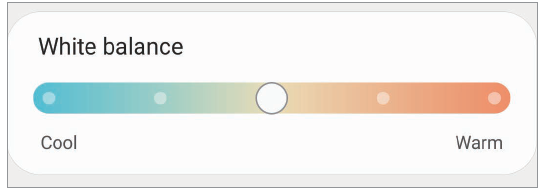
Adjusting the screen tone by colour value
Increase or lower certain colour tones by adjusting the Red, Green, or Blue value individually.
- On the Settings screen, tap Display → Screen mode → Vivid.
- Tap Advanced settings.
- Adjust the R (Red), G (Green), or B (Blue) colour bar to your preference.
The screen tone will be adjusted.
Font size and style
Change the font size and style.
- On the Settings screen, tap Display → Font size and style.
Change the font style and boldness setting and drag the adjustment bar under Font size to change the size.

Screen resolution
Change the screen resolution. It is set to FHD+ by default. Higher resolutions make the display more vivid, however they will consume more battery power.
- On the Settings screen, tap Display → Screen resolution.
- Select a resolution option and tap Apply.
Some currently running apps may close when you change the resolution.
Screensaver
You can set to display images as a screensaver when the screen turns off automatically. The screensaver will be displayed when the device is charging.
- On the Settings screen, tap Display → Screensaver.
- Select an option.
If you select Photo Frame or Photos, a slideshow with selected images will start. If you select Photo Table, selected images will appear as small cards and overlap. - Tap
.png) to select albums for displaying images.
to select albums for displaying images. - When you are finished, tap the Back button.
To preview the selected option, tap Preview.
TIP
When you tap the screen while your screensaver is displayed, the screen will turn on.
Setup Guide
To set up the Samsung G988B-DS Galaxy S20 Ultra 5G, follow these steps:
- Insert the SIM card and, if necessary, the microSD card.
- Press and hold the power button until the device turns on.
- Follow the on-screen instructions to set up the device, including language, network, and account preferences.
- If prompted, update the device's software to the latest version.
- Configure security features, such as fingerprint or face recognition, and set up any desired additional features, such as Samsung Pay or Bixby Voice.
Wallpaper
Change the wallpaper settings for the Home screen and the locked screen.
On the Settings screen, tap Wallpaper.
Themes
Apply various themes to the device to change the visual elements of the Home screen, locked screen, and icons.
On the Settings screen, tap Themes.
- Themes: Change the device’s theme.
- Wallpapers: Change the wallpaper settings for the Home screen and the locked screen.
- Icons: Change the icon style.
- AODs: Select an image to display on the Always On Display.
Lock screen
Options
Change the settings for the locked screen. On the Settings screen, tap Lock screen.
TIP
The available options may vary depending on the screen lock method selected.
- Screen lock type: Change the screen lock method.
- Smart Lock: Set the device to unlock itself when trusted locations or devices are detected. Refer to Smart Lock for more information.
- Secure lock settings: Change screen lock settings for the selected lock method.
- Always On Display: Set the device to display information while the screen is turned off. Refer to Always On Display for more information.
- Wallpaper services: Set the device to use wallpaper services such as Dynamic Lock screen.
- Clock style: Change the type and colour of the clock on the locked screen.
- Roaming clock: Change the clock to show both the local and home time zones on the locked screen when roaming.
- Face Widgets: Change the settings of the items displayed on the locked screen.
- Contact information: Set the device to show contact information, such as your email address, on the locked screen.
- Notifications: Set how to show notifications on the locked screen.
- Shortcuts: Select apps to display shortcuts to them on the locked screen.
- About the Lock screen: View the Lock screen version and legal information.
Smart Lock
You can set the device to unlock itself and remain unlocked when trusted locations or devices are detected.
For example, if you have set your home as a trusted location, when you get home your device will detect the location and automatically unlock itself.
TIP
- This feature will be available to use after you set a screen lock method.
- If you do not use your device for four hours or when you turn on the device, you must unlock the screen using the pattern, PIN, or password you set.
1 On the Settings screen, tap Lock screen → Smart Lock.
2 Unlock the screen using the preset screen lock method.
3 Select an option and follow the on-screen instructions to complete the setup.
Recording an 8K video
- Launch the Camera app.
- On the shooting modes list, tap VIDEO.
- In the shooting options, tap
 .
. - Select
 and record a video.
and record a video.
Q. When zooming in on the preview screen, a square window appears on the top of the screen. What is that?
A. If the zoom ratio exceeds a certain level, the window will appear to indicate where you are zooming in on the image.
Q. When I tap the ![]() icon in the Gallery app, some images disappear. What happened?
icon in the Gallery app, some images disappear. What happened?
A. When you tap the ![]() icon, similar images are grouped and only a preview of the images will be displayed on the list. When you tap the image preview, you can view all the images in the group.
icon, similar images are grouped and only a preview of the images will be displayed on the list. When you tap the image preview, you can view all the images in the group.
Q. In the Gallery app, the items I deleted moved to the recycle bin without being completely deleted. How can I delete the items in the recycle bin?
A. The items moved to the recycle bin are automatically deleted after a certain period. To delete them manually, follow the directions below.
- In the Gallery app, tap
 → Recycle bin.
→ Recycle bin. - Tap and hold an item to delete, and tap Delete.
Troubleshooting of Samsung G988B-DS Galaxy S20 Ultra 5G
Before contacting a Samsung Service Centre, please attempt the following solutions. Some situations may not apply to your device. When you turn on your device or while you are using the device, it prompts you to enter one of the following codes:
- Password: When the device lock feature is enabled, you must enter the password you set for the device.
- PIN: When using the device for the first time or when the PIN requirement is enabled, you must enter the PIN supplied with the SIM or USIM card. You can disable this feature by using the Lock SIM card menu.
- PUK: Your SIM or USIM card is blocked, usually as a result of entering your PIN incorrectly several times. You must enter the PUK supplied by your service provider.
- PIN2: When you access a menu requiring the PIN2, you must enter the PIN2 supplied with the SIM or USIM card. For more information, contact your service provider.
Your device displays network or service error messages
- When you are in areas with weak signals or poor reception, you may lose reception. Move to another area and try again. While moving, error messages may appear repeatedly.
- You cannot access some options without a subscription. For more information, contact your service provider.
Your device does not turn on
When the battery is completely discharged, your device will not turn on. Fully charge the battery before turning on the device.
The touchscreen responds slowly or improperly
- If you attach a screen protector or optional accessories to the touchscreen, the touchscreen may not function properly.
- If you are wearing gloves, if your hands are not clean while touching the touchscreen, or if you tap the screen with sharp objects or your fingertips, the touchscreen may malfunction.
- The touchscreen may malfunction in humid conditions or when exposed to water.
- Restart your device to clear any temporary software bugs.
- Ensure that your device software is updated to the latest version.
- If the touchscreen is scratched or damaged, visit a Samsung Service Centre.
Your device freezes or encounters a fatal error
Try the following solutions. If the problem is still not resolved, contact a Samsung Service Centre.
- Restarting the device
If your device freezes or hangs, you may need to close apps or turn off the device and turn it on again. - Forcing restart
If your device is frozen and unresponsive, press and hold the Side key and the Volume Down key simultaneously for more than 7 seconds to restart it. - Resetting the device
If the methods above do not solve your problem, perform a factory data reset. Launch the Settings app and tap General management → Reset → Factory data reset → Reset → Delete all. Before performing the factory data reset, remember to make backup copies of all important data stored in the device.
Calls are not connected
- Ensure that you have accessed the right cellular network.
- Ensure that you have not set call barring for the phone number you are dialling.
- Ensure that you have not set call barring for the incoming phone number.
Others cannot hear you speaking on a call
- Ensure that you are not covering the built-in microphone.
- Ensure that the microphone is close to your mouth.
- If using an earphone, ensure that it is properly connected.
The sound echoes during a call
Adjust the volume by pressing the Volume key or moving to another area.
A cellular network or the Internet is often disconnected or audio quality is poor
- Ensure that you are not blocking the device’s internal antenna.
- When you are in areas with weak signals or poor reception, you may lose reception. You may have connectivity problems due to issues with the service provider’s base station. Move to another area and try again.
- When using the device while moving, wireless network services may be disabled due to issues with the service provider’s network.
The battery does not charge properly (For Samsung-approved chargers)
- Ensure that the charger is connected properly.
- Visit a Samsung Service Centre and have the battery replaced.
The battery depletes faster than when first purchased
- When you expose the device or the battery to very cold or very hot temperatures, the useful charge may be reduced.
- Battery consumption will increase when you use certain features or apps, such as GPS, games, or the Internet.
- The battery is consumable and the useful charge will get shorter over time.
Error messages appear when launching the camera
Your device must have sufficient available memory and battery power to operate the camera app. If you receive error messages when launching the camera, try the following:
- Charge the battery.
- Free some memory by transferring files to a computer or deleting files from your device.
- Restart the device. If you are still having trouble with the camera app after trying these tips, contact a Samsung Service Centre.
The photo quality is poorer than the preview
- The quality of your photos may vary, depending on the surroundings and the photography techniques you use.
- If you take photos in dark areas, at night, or indoors, image noise may occur or images may be out of focus.
Error messages appear when opening multimedia files
If you receive error messages or multimedia files do not play when you open them on your device, try the following:
- Free some memory by transferring files to a computer or deleting files from your device.
- Ensure that the music file is not Digital Rights Management (DRM)-protected. If the file is DRM-protected, ensure that you have the appropriate licence or key to play the file.
- Ensure that the file formats are supported by the device. If a file format is not supported, such as DivX or AC3, install an app that supports it. To confirm the file formats that your device supports, visit https://www.samsung.com
- Your device supports photos and videos captured with the device. Photos and videos captured by other devices may not work properly.
- Your device supports multimedia files that are authorized by your network service provider or providers of additional services. Some content circulated on the Internet, such as ringtones, videos, or wallpapers, may not work properly.
Bluetooth is not working well
If another Bluetooth device is not located or there are connection problems or performance malfunctions, try the following:
- Ensure that the device you wish to connect with is ready to be scanned or connected to.
- Ensure that your device and the other Bluetooth device are within the maximum Bluetooth range (10 m).
- On your device, launch the Settings app, tap Connections, and then tap the Bluetooth switch to re-activate it.
- On your device, launch the Settings app, tap General management → Reset → Reset network settings → Reset settings → Reset to reset network settings. You may lose registered information when performing the reset.
If the tips above do not solve the problem, contact a Samsung Service Centre.
A connection is not established when you connect the device to a computer
- Ensure that the USB cable you are using is compatible with your device.
- Ensure that you have the proper driver installed and updated on your computer.
Your device cannot find your current location
GPS signals may be obstructed in some locations, such as indoors. Set the device to use Wi-Fi or a mobile network to find your current location in these situations.
Data stored in the device has been lost
Always make backup copies of all important data stored in the device. Otherwise, you cannot restore data if it is corrupted or lost. Samsung is not responsible for the loss of data stored in the device.
A small gap appears around the outside of the device case
- This gap is a necessary manufacturing feature and some minor rocking or vibration of parts may occur.
- • Over time, friction between parts may cause this gap to expand slightly.
There is not enough space in the device’s storage
Delete unnecessary data, such as cache, using the device care feature or manually delete unused apps or files to free up storage space.
The Home button does not appear
The navigation bar containing the Home button may disappear while using certain apps or features. To view the navigation bar, drag upwards from the bottom of the screen.
The screen brightness adjustment bar does not appear on the notification panel
Open the notification panel by dragging the status bar downwards, and then drag the notification panel downwards. Tap ![]() → Quick panel layout and tap the Show brightness on top switch to activate it.
→ Quick panel layout and tap the Show brightness on top switch to activate it.
Removing the battery
- To remove the battery, contact an authorized service centre. To obtain battery removal instructions, please visit www.samsung.com/global/ecodesign_energy.
- For your safety, you must not attempt to remove the battery. If the battery is not properly removed, it may lead to damage to the battery and device, cause personal injury, and/or result in the device being unsafe.
- Samsung does not accept liability for any damage or loss (whether in contract or tort, including negligence) which may arise from failure to precisely follow these warnings and instructions, other than death or personal injury caused by Samsung’s negligence.
Pros & Cons
- Pros:
- Stunning display
- Powerful performance
- Advanced camera capabilities
- Long-lasting battery
- Cons:
- High price point
- Bulky design
- No 3.5mm headphone jack
Faqs
What is the screen size of the Samsung?
What is the battery capacity of the device?
What is the highest storage option available for the device?
What is the camera setup of the device?
How much RAM does the device have?
What processor does the device use?
What is the resolution of the display?
Leave a Comment
